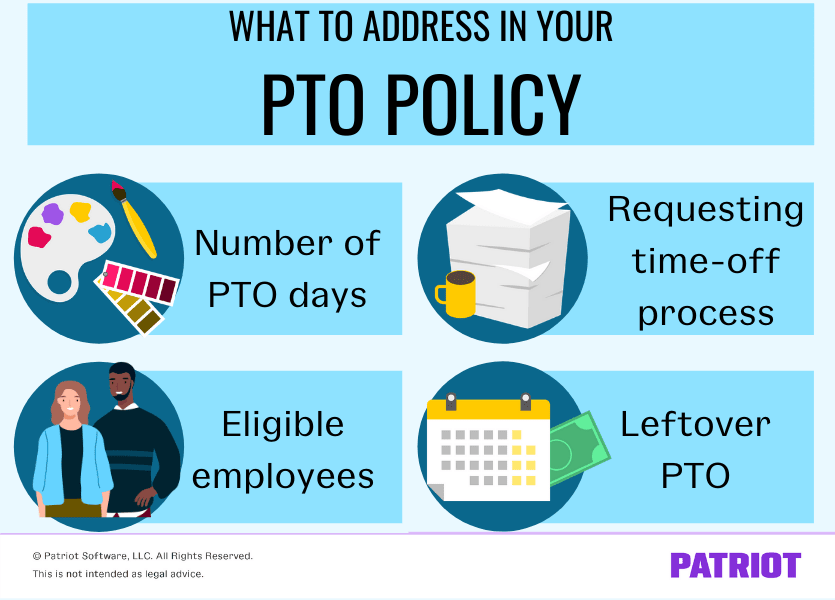Thinking about giving your employees paid sick or vacation days? Why not combine them under one paid time off plan?
The U.S. Bureau of Labor Statistics (BLS) says that 41% of private sector workers have access to a consolidated leave plan. That means employees can use paid time off for any reason.
Get the 411 on what is paid time off, why it can benefit your business and employees, and how to establish your policy.
What is paid time off?
Paid time off (PTO) lets employees earn their regular wages when they take time off from work. Unlike paid vacation and sick leave policies, a paid time off policy lets employees take time off work for any reason. PTO is a common part of an employee’s benefits package. Generally, employees receive their paid time off in one lump sum at the beginning of the year.
Employees might be able to use paid time off for things like:
- Sickness
- Vacation
- Personal days
- Bereavement
- Jury duty
You might offer additional paid time off for federal legal holidays, such as Memorial Day, Thanksgiving, and Christmas.
PTO allows employees to rest and spend time with loved ones—without losing money. This could boost employee morale and productivity.
Do you have to offer PTO days?
There is no federal law that says you must offer employees paid time off. But, state laws are a different story.
Maine and Nevada have paid leave laws that require employers to offer employees PTO for any reason. And, there are a number of states with paid sick leave laws.
Check with your state for specific requirements (e.g., eligible employers, number of days off, etc.). Some localities also have paid leave rules, so check local laws.
Should you offer employees paid time off?
Offering paid time off to employees can be a huge advantage for small businesses. While PTO can get expensive for employers, the return might be worth the cost.
Here are some reasons to consider offering employees PTO.
1. Increased employee engagement and retention
According to a study by Patriot Software, the second biggest reason for disengagement and turnover is having an insufficient work-life balance—something 24.3% of surveyed workers reported. And we all know that one way to have a better work-life balance is to take time away from work to focus on, well, life.
Acknowledging that employees have lives outside the workplace is a big morale-booster. Employees appreciate the time off to take care of a sick child, go on vacation, or simply have a personal day.
Morale and engagement typically go hand in hand. When morale increases, so does engagement. And when engagement increases, retention is sure to follow. The more employees enjoy their benefits, the more apt they’ll be to stay with a business.
2. Boosted productivity
Employees in need of a break probably won’t be at the top of their productivity game. But with paid time off, employees have the opportunity to rest and not worry about missing work.
The time off can make an employee feel valued, which often turns into being a more productive worker. And, the employee might come back from their PTO feeling rejuvenated and ready to work.
3. Decreased absenteeism rate
When employees receive PTO, they are less likely to call off unexpectedly. PTO lets employees schedule their time off in advance and give you notice.
By giving employees PTO and requiring advance notice, there’s likely less absenteeism in the workplace. And, that leads to a more predictable work environment and an equal distribution of responsibilities.
4. Increased recruitment opportunities
As a small business owner, you might feel like large companies have a leg up when it comes to recruiting top talent…
…Which is why you need to offer an enticing benefits package. Offering PTO can help you secure top talent.
Setting up your paid time off policy
If you decide to offer PTO at your business, you need a paid time off policy. The policy explains the rules employees should follow to use their PTO. Add your business’s PTO policy to your employee handbook.
Your paid time off policy should address:
- Number of PTO days
- Eligible employees
- Requesting time-off process
- Leftover PTO

Number of PTO days
The Question: How many days off do employees receive?
Your policy needs to detail how many days of PTO employees receive each year. Often, PTO days vary based on the employee’s years of service.
For example, you might do something like:
- 1 – 4 years: 15 days
- 5-9 years: 17 days
- 10+ years: 22 days
Decide how much paid time off an employee can use per year and whether there are any rules on when they can use them. For example, you might limit consecutive PTO to 10 days.
Eligible employees
The Question: Who is eligible to receive PTO?
Decide which employees can receive paid time off. You might establish a waiting period before employees can accrue and/or use paid time off. For example, an employee may need to be with your business for 90 calendar days before they can use PTO.
You may also limit which employees are eligible for PTO. For example, you might only offer paid time off to full-time employees.
Requesting time-off process
The Question: How do employees go about requesting their PTO?
Your policy should address:
- How far in advance employees should request PTO
- Whether employees need to tell you in person or provide a written request
- What happens if too many employees request the same time off
For example, you might require employees taking more than five days off at once to give you one month’s notice in writing. And, you may prioritize vacation requests on a first-come-first-serve basis.
Leftover PTO
The Question: What happens to an employee’s unused PTO at the end of the year?
Detail what happens to any unused PTO at the end of the year. And, let employees know what happens to unused PTO if they leave your business.
Your policy should answer whether:
- An employee can roll over leftover PTO
- An employee can cash out unused PTO
- There are any rollover or cash out restrictions or limitations
Although most states don’t have laws requiring that employers offer paid time off, many do have rules employers need to follow regarding unused vacation time.
Your state’s laws might prevent you from implementing a use-it-or-lose-it policy, require that you provide PTO payout to employees leaving your business, or both.
Looking for a better way to track your employees’ PTO and hours worked? Patriot’s online payroll lets you complete payroll in three simple steps. Plus, our software integrates with time and attendance software solutions. Get your free trial today!
This article has been updated from its original publication date of April 20, 2012.
This is not intended as legal advice; for more information, please click here.